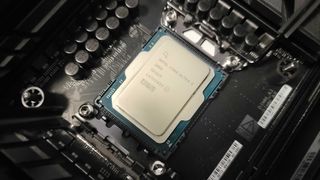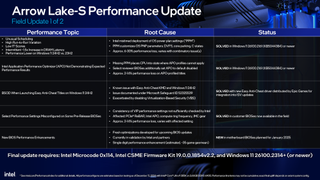Intel announces Arrow Lake performance fix is now available — another update coming next month
Time to test.

Intel announced that its first wave of updates to address the gaming performance issues plaguing the Arrow Lake processors is now available. Intel says the updates available today will deliver "signficant performance upside" and restore the "complete and intended functionality" of the Core Ultra 200S Arrow Lake processors. We're currently testing the fixes and have summarized the root causes below.
Intel's update comes after a disappointing round of Core Ultra 200S launch day reviews, which found wildly variable gaming performance recorded by different media outlets. Those results overwhelmingly did not match the performance benchmarks that Intel had shared before the launch, leading to an overall poor reception for the Arrow Lake processors. Last month, Intel's Robert Hallock announced that an investigation was underway, saying the company planned to restore gaming performance to its original targets and would share details this month.
The update requires both a new motherboard BIOS firmware and a Windows update that also corrects several issues. Intel advises its customers to update to the latest BIOS from their motherboard vendor and to update Windows to build 26100.2314 (or newer).

In January, Intel will issue a final component — a new BIOS revision that provides additional performance beyond what was originally promised. These are features and improvements developed after that launch. Intel says the final update will add an additional single-digit percentage increase in gaming performance. At CES 2025, Intel will issue a full A/B performance analysis of the issues and new benchmarks reflecting the performance of the entire fix.
Intel identified five root causes, four of which are already addressed by updates available today. We'll cover Intel's list of the root causes, and then we'll give a synopsis of the fix for each.
Intel Arrow Lake Root Causes
- 1. A missing Performance & Power Management (PPM) package.
- 2. Intel Application Performance Optimizer (APO) could not take effect.
- 3. BSODs when attempting to launch game titles utilizing the Easy Anti-Cheat service.
- 4. Select performance settings misconfigured on reviewer or early enabling BIOSes.
- 5. New BIOS performance optimizations.
1.) The Performance & Power Management (PPM) package dictates how the Windows Power Plans control the CPU's behavior. The PPM is typically delivered through a chipset driver of Windows Update. Intel says that a missing or malfunctioning PPM impacts multiple performance facets (details in the accompanying blog post), thus reducing performance by 6 to 30% (est.), depending on the workload or other extenuating factors.
Intel says it incorrectly scheduled this update for 'user/retail availability' but not for reviewer availability. The PPM is now added in Windows 11 build 26100.2161 (KB5044384) or newer. It has been available in Windows Update since November.
Stay On the Cutting Edge: Get the Tom's Hardware Newsletter
Get Tom's Hardware's best news and in-depth reviews, straight to your inbox.
During a YouTube live stream at Hot Hardware, Robert Hallock confirmed that the correct PPM package was not available to press for reviews, either in Windows Update or the chipset drivers. Intel says the impact of this can vary tremendously, so we'll have to test to see how it impacts our gaming results.
2.) Intel's Application Performance Optimizer (APO) boosts game performance in several game titles. This software utility is now automatically installed by default in Windows, but it also had to be manually enabled in some BIOSes (we confirmed the feature was enabled in our testing). Intel says the incorrect PPM (covered above) resulted in APO not working as intended, costing anywhere from 2% to 14% of performance. This is now resolved with the addition of the correct PPM package.
3.) The BSOD issues caused by anti-cheat software have been resolved by an Easy Anti-Cheat driver update that Epic Games is distributing to the relevant publishers and developers.
4.) Intel cites that the motherboard BIOSes provided to reviewers had incorrect default settings for a range of "VIP settings." The number of incorrect settings and the settings impacted varied by vendor. These included settings like "PCIe Resizable BAR, Intel APO, compute tile ring frequency, memory controller ratio (gear), sustained/transient power limits, and more."
Intel cited a whole host of potential effects, including "aberrantly high memory latency (~1.5-2.0x expected); erratic or fluctuating compute tile ring frequency; high run-to-run stdev [standard deviation] for dynamic or unpredictable workloads; no performance uplift for games that benefit from PCIe Resizable BAR; no performance uplift for games that benefit from Intel APO."
Intel says this impacted performance anywhere from 2% to 14% (the same as the performance loss from APO not working correctly). Intel said it did not correctly enforce the VIP settings with motherboard vendors. All new BIOS revisions correct this issue.
5.) Intel will issue a new BIOS and CSME firmware kit in the first half of January 2025, but the availability will vary depending on the vendor. This final update will include an undisclosed "small selection of performance optimizations" developed after the launch. Intel says this update will add another single-digit percentage of gaming performance (as measured by Intel with a geomean of ~35 games).
This new firmware update is Intel microcode version 0x114 and Intel CSME Firmware Kit 19.0.0.1854v2.2 (or newer). The 0x114 microcode will not work correctly unless paired with the CSME Firmware Kit. The CSME is fully encapsulated within the BIOS update, so it doesn't require other driver updates.
Thoughts
Intel says the currently available Windows and firmware updates will bring Arrow Lake to the promised performance levels — the newer BIOS coming in January is just an additional level of performance beyond Intel's original projections. We've also seen that software updates, such as the Cyberpunk 2077 update that increases performance by up to 33%, can also significantly improve Arrow Lake's standing. Both of those are promising developments.
We've also seen beta testing of the new 0x114 microcode slated for release in January. Those initial tests show little to no performance improvements, but that is with the caveat that the firmware requires the accompanying CSME Firmware Kit to work correctly, which isn't available yet. That invalidates the testing. We'll have to wait for the official versions of the 0x114 microcode to pass judgment.
In the meantime, all that's left to do is test Intel's claims that the performance issues are corrected with the updates available today. As you can imagine, we're already busy testing the changes. Stay tuned.

Paul Alcorn is the Managing Editor: News and Emerging Tech for Tom's Hardware US. He also writes news and reviews on CPUs, storage, and enterprise hardware.
-
rluker5 This is good. I'm looking forward to the test results.Reply
For starters not having a properly functioning Windows power plan on a hybrid CPU could make a big difference. What a mess of a launch if the performance goes up as much as claimed.
It might have had something to do with Gelsinger's departure. -
TCA_ChinChin Reply
I agree that it was a mess of a launch but I can't imagine Gelsinger leaving had too much of an impact. Can't imagine what a CEO is needed for a launch that's been planned for months. To me its just they rushed things out a little premature, they really wanted it out by a specific date regardless of kinks.rluker5 said:This is good. I'm looking forward to the test results.
For starters not having a properly functioning Windows power plan on a hybrid CPU could make a big difference. What a mess of a launch if the performance goes up as much as claimed.
It might have had something to do with Gelsinger's departure. -
hotaru251 Reply
restore the "complete and intended functionality"
....except their own slide performance was about what the original reviews were getting...so it was intended to be that bad... -
Eximo ReplyEzzyB said:So now even CPUs need a zero-day patch...
Well, they sort of always have in the form of new motherboard BIOS/Chipsets.
Zero day patch assumes they have the patch ready but have already shipped the product. Not so in this case.
I would call this a day one patch. As in needing a patch from day one. -
svan71 Wow, I'm just so used to bios and microcode updates decreasing performance I don’t know what to say.Reply -
thestryker The most recent BIOS updates from MSI have been available in beta form since the end of Oct. Will have to check on the MS KB as I purposely installed Win 11 23H2 when setting up my system. I've done Windows updates and a BIOS update since my first 3DMark test and the CPU score went up a fair bit between the two despite identical clocks so something in there did help out.Reply
threw in a run from the old system for fun
https://i.imgur.com/dDciF8L.jpeg
I don't really expect any of these things to make a real overall difference, but if they can knock down the outliers that would be good.
While they're at it Intel should really do something about the absurdity of installing the management engine. Unless it has changed recently the only simple way to install it is through Windows (when I had to do it on my server box it was faster to just put a drive with Windows on it in and boot that to install). -
DS426 The Windows build was mentioned multiple times by Intel and this article, but it would have been clearer if they added the build translation of Windows 11 24H2 as some might have updated to December's update but I assume would not have Intel's updates if still on 23H2, which many folks still would be.Reply
Intel wants their own brand of Fine Wine like AMD these days, a? -
endocine Fear that despite this, and whatever gains or stability improvements result, the damage is done to their reputation, especially after the raptorlake cpu failures. Its also highly unlikely that arrow lake is going to notch wins against the beastly 9800X3d.Reply
"Intel's Application Performance Optimizer (APO) boosts game performance in several game titles. This software utility is now automatically installed by default in Windows"
-Don't have to install an app to make the CPU work properly on AMD -
helper800 Reply
IMO arrow lake does not need to beat the 9800X3D, it just needs to beat the 13000 and 14000 series, and the 7000 and 9000 series non-X3D CPUs.endocine said:Fear that despite this, and whatever gains or stability improvements result, the damage is done to their reputation, especially after the raptorlake cpu failures. Its also highly unlikely that arrow lake is going to notch wins against the beastly 9800X3d.
"Intel's Application Performance Optimizer (APO) boosts game performance in several game titles. This software utility is now automatically installed by default in Windows"
-Don't have to install an app to make the CPU work properly on AMD
Most Popular




